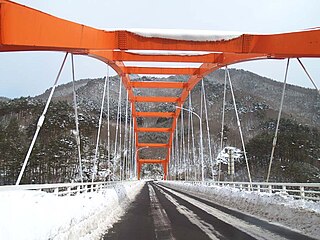
Tōno is a city in Iwate Prefecture, Japan. As of 1 January 2020, the city had an estimated population of 26,378, and a population density of 31.6 persons per km2 in 10,759 households. The total area of the city is 825.97 square kilometres (318.91 sq mi). Tōno is known as "The City of Folklore" for its rural nature, its preservation of traditional culture and especially for the collection of folktales, Tōno Monogatari, written by Kunio Yanagita in 1910.
The world's principal religions and spiritual traditions may be classified into a small number of major groups, though this is not a uniform practice. This theory began in the 18th century with the goal of recognizing the relative levels of civility in different societies, but this practice has since fallen into disrepute in many contemporary cultures.

Miyamori was a village located in Kamihei District, Iwate Prefecture, Japan.

Kamihei District is a rural district in Iwate Prefecture, Japan.

The Shinano River, known as the Chikuma River in its upper reaches, is the longest and widest river in Japan and the third largest by basin area. It is located in northeastern Honshu, rising in the Japanese Alps and flowing generally northeast through Nagano and Niigata Prefectures before emptying into the Sea of Japan.

The Kuma River is a river in Kumamoto Prefecture, central Western part of Kyūshū, Japan. It is sometimes referred as Kumagawa River. It is the longest river in Kyushu, with the length of 115 km long and has a drainage area of 1,880 km2 (730 sq mi). The tidal flat of the Kuma River estuary is approximately 1000 hectares.

Saru River is a river in Hokkaidō, Japan.
Shinsengumi! (新選組!) is a 2004 Taiga drama historical fiction television series produced by Japanese broadcaster NHK. It was a popular drama about the Shinsengumi, a Japanese special police force from the Bakumatsu period.

Malampuzha Dam is the largest dam and reservoirs in Kerala, located near Palakkad, in the state of Kerala in South India, built post independence by the then Madras state. Situated in the scenic hills of the Western Ghats in the background it is a combination of a masonry dam with a length of 1,849 metres and an earthen dam with a length of 220 metres making it the longest dam in the state. The dam is 355 feet high and crosses the Malampuzha River, a tributary of Bharathappuzha, Kerala's second longest river. There is a network of two canal systems that serve the dam's reservoir of 42,090 hectares.

The iron Inariyama burial-mound sword or kinsakumei tekken (金錯銘鉄剣) was excavated at the Inariyama Kofun in 1968. Inariyama Kofun is a megalithic tomb located in Saitama Prefecture. In 1978, X-ray analysis revealed a gold-inlaid inscription that comprises at least 115 Chinese characters. This sword was described as the discovery of the century for the study of ancient Japanese history. The sword is designated a national treasure of Japan.

National Route 283 is a national highway connecting Kamaishi, Iwate and Hanamaki, Iwate in Japan, with a total length of 89.3 km (55.49 mi).
Niikappu River is a river in Hokkaidō, Japan.

Masuzawa Station is a railway station in the city of Tōno, Iwate, Japan, operated by East Japan Railway Company.

The Gōnokawa River is a river that runs through Hiroshima and Shimane prefectures in Japan. It is the largest river in the Chūgoku region. It is also called the Gōgawa River and, in Hiroshima, the Enokawa River.

Invented traditions are cultural practices that are presented or perceived as traditional, arising from the people starting in the distant past, but which in fact are relatively recent and often even consciously invented by identifiable historical actors. The concept was highlighted in the 1983 book The Invention of Tradition, edited by Eric Hobsbawm and Terence Ranger. Hobsbawm's introduction argues that many "traditions" which "appear or claim to be old are often quite recent in origin and sometimes invented." This "invention" is distinguished from "starting" or "initiating" a tradition which does not then claim to be old. The phenomenon is particularly clear in the modern development of the nation and of nationalism, creating a national identity promoting national unity, and legitimising certain institutions or cultural practices.
Borrelia japonica is a spirochete bacterium first isolated from Japanese mammals.
Tomoko Masuzawa is professor emerita of comparative literature and history at the University of Michigan. In 1979, she received her MA in religious studies at Yale University. Masuzawa received her PhD in religious studies from University of California Santa Barbara in 1985. European intellectual history, discourses on religion, history of religion, and psychoanalysis are Masuzawa’s fields of study.
Neo-Dada Organizers, often shortened to Neo-Dada (ネオ・ダダ), was a short-lived but influential Japanese Neo-Dadaist art collective formed by Masunobu Yoshimura in 1960. Composed of a small group of young, up-and-coming artists who met periodically at Yoshimura's "White House" atelier in Shinjuku, the Neo-Dada Organizers engaged in all manner of visual and performance artworks, but specialized in producing disturbing, impulsive spectacles, often involving physical destruction of objects, that the art critic Ichirō Hariu deemed "savagely meaningless," and that inspired another art critic, Yoshiaki Tōno, to coin the term "anti-art" (han-geijutsu). Examples included filling galleries with piles of garbage, smashing furniture to the beat of jazz music, and prancing the streets of Tokyo in various states of dress and undress. Using the human body as their medium of art, their violent performances reflected both their dissatisfaction with the restrictive environment of the Japanese art world at the time, as well as contemporary social developments, most notably the massive 1960 Anpo protests against the U.S.-Japan Security Treaty.











